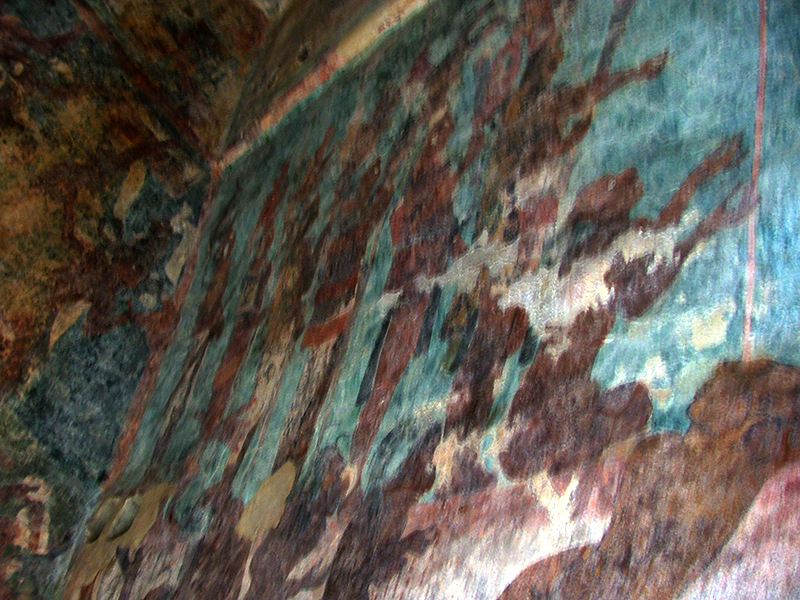

Robert Sharer writes: "Room 2 is filled with one of the true masterpieces of Maya art, a vivid and dynamic battle scene that covers the walls and vaults of all but the north side of the room.
The confusion and horror of hand-to-hand combat is brilliantly depicted, although the scene has suffered damage that obscures many of the details. Spears are thrust and thrown, one penetrates the forehead of a warrior, prisoners are pulled down by their hair, and pairs of victors combine to overwhelm single enemy warriors.
Robert Sharer, The Ancient Maya, p. 255
When the murals in Room 2 were discovered, they caused huge controversy among experts since the murals clearly depicted war, torture and bloody rituals at a time when it was believed the Maya were a peace loving people.

Robert Sharer continues: " At the focus of the scene stands the war leader, standing full front and grasping a captive by the hair while holding in his other hand a thrusting spear decorated by a jaguar pelt (south wall, upper register).
This figure, identified as Chan Muan, is accompanied by another elite warrior who may be an allied ruler (possible Shield Jaguar III from Yaxchilan); both wear jaguar tunics and elaborate headdresses, and each is protected by an entourage of elite warriors."
Robert Sharer, The Ancient Maya, p. 255
Chaan Muan, in jaguar-pelt vest, matching booties, and wearing a belt of jaguar teeth, surveys the pyramid while the pleading hands of the displayed captives beg for mercy.
Perhaps the pyramid depicted is an idealized version of Vulture Hill, upon which the acropolis of Bonampak rises.

"The murals in Room 3 depict a final orgy of autosacrifice and captive dismemberment, all arrayed against a large pyramid that reaches around east, south, and west walls."
Mary Ellen Miller, Maya Art and Architecture, p. 176-77.
Maya aristocratic life seems to have been dedicated to living out predetermined cultural scripts which eventually became too expensive to maintain. Kathleen Berrin writes:
"The ideal script the lords and ladies wrote for their live increasingly may have been in disharmony with the world around them, and evidently the required price was too high."
Kathleen Berrin, Courtly Art of the Ancient Maya, p. 15
I find it astonishing that shortly after the murals were completed, both Bonampak & Yaxchilan entered a sharp decline and by 900 AD only the Lacandon tribal people, the encroaching jungle, and abandoned cities remained.
Overpopulation, exhausted farmland, perpetual petty warfare, and deforestation were ever present. Perhaps that is why those who were left wanted to deface the eyes on the murals & stelae to blunt their power.